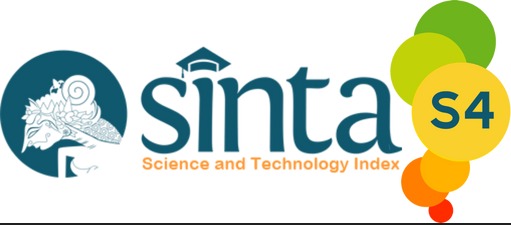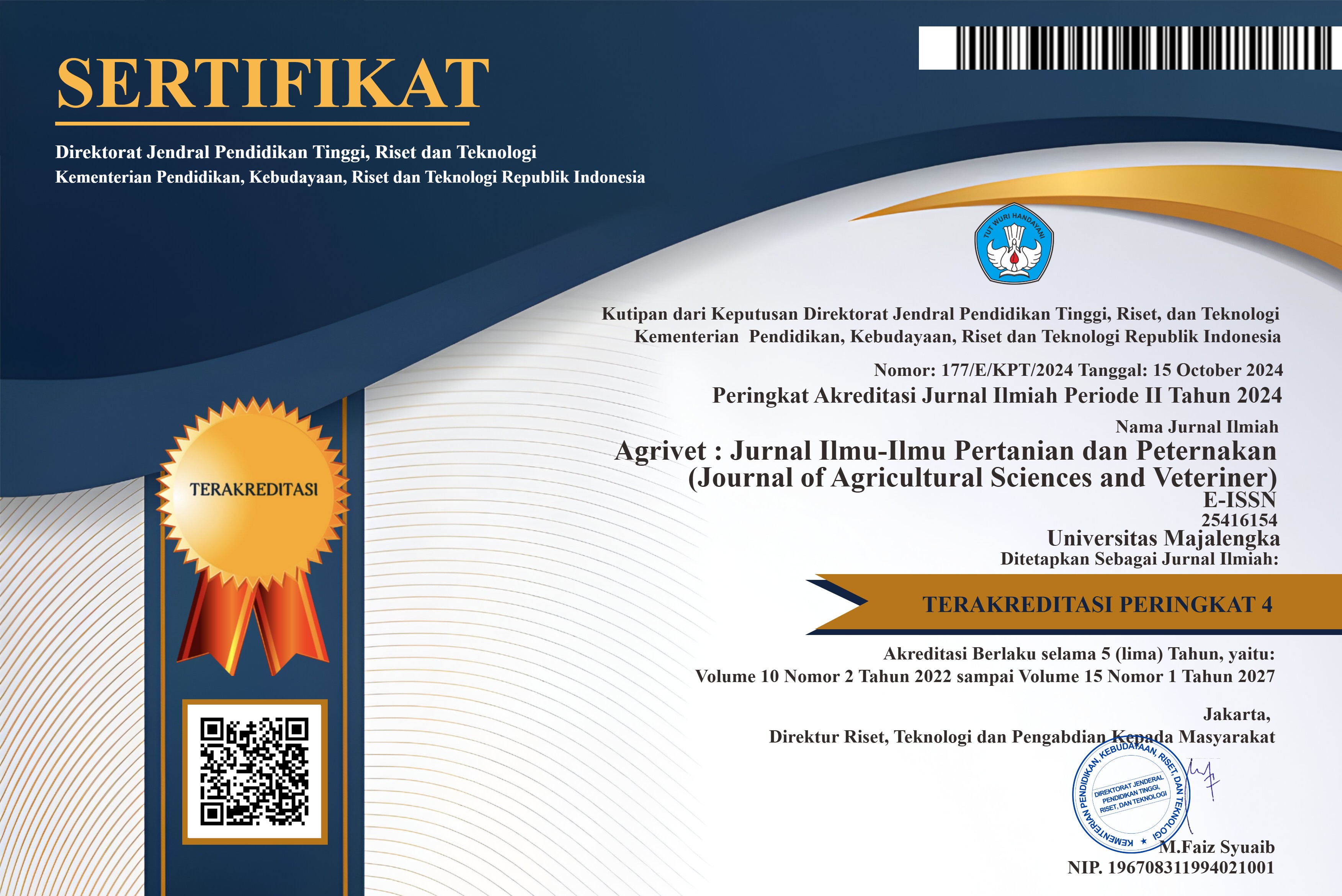Respons kedelai (Glycine max) varietas Mitani terhadap pemberian beberapa jenis pupuk hayati pada tanah podsolik
DOI:
https://doi.org/10.31949/agrivet.v11i2.7397Abstract
This study aimed to examine the growth response and yield of Mitani variety soybean plants after treating them with Rhizobium biofertilizer, Phosphate Solvent Microbes, and Azotobacter using gamma-ray irradiation technology. This research was conducted from January to May 2016 and used one-factor Randomized Block Design (RBD) with the several biofertilizer formulas treatments. The treatments level used were K0 = without fertilizer (control); K+ = 100% urea; Rhi = single strain Rhizobium; Rhi+MPF = Rhizobium Inoculant + Phosphate Solvent Microbes; and Rhi+MPF+AZ = Rhizobium + MPF + Azotobacter. Each application of biological fertilizer is mixed with 50% urea fertilizer. The data obtained were analyzed using the F-test (ANOVA) and continued with the Duncan Multiple Range Test (DMRT) at a confidence level α = 0.05. The results showed that the best plant height occurred in soybeans that were given rhizobium fertilizer and pophat solvent microorganisms. Meanwhile, the best average wet and dry weight of soybean plants (p<0.05) occurred in the 100% urea fertilizer treatment. Apart from that, the application of 100% urea fertilizer produces plants with higher water content compared to the biological fertilizer treatment. Another finding from this research is that the number of pods is not directly proportional to the weight of the root nodules. Generaly, it can be concluded that soybean plants respond more to urea fertilization than biological fertilizer.
Keywords:
Microbial Population , Biological Agents , irradiation technology, gamma raysDownloads
References
Aasfar, A., Bargaz, A., Yaakoubi, K., & Hilali, A. (2021). Nitrogen Fixing Azotobacter Species as Potential Soil Biological Enhancers for Crop Nutrition and Yield Stability. 12(February), 1–19. https://doi.org/10.3389/fmicb.2021.628379
Abdillah, M. H., & Aldi, M. (2021). Aplikasi Limbah Padat Karet Remah Pada Tanah Podsolik Merah Kuning Terhadap Ketersediaan Hara Makro Dan Perbaikan Sifat Fisika Tanah. EnviroScienteae, 16(2), 264–275. https://doi.org/10.20527/es.v16i2.9658
Bachtiar, T., & Waluyo, S. H. (2013). Pengaruh pupuk hayati terhadap pertumbuhan dan effect of biofertilizer on growth and nitrogen uptake of soybean plants ( glycine max . L .) Varieties mitani and. Widyariset, 16(3), 411–418.
Badan Teknologi Nuklir Nasional. (2016). Kedelai varietas baru hasil pemuliaan mutasi. In Atomos : Media Informasi Ilmu Pengetahuan dan Teknologi Nuklir (pp. 1–6). http://drive.batan.go.id/kip/documents/leaflet2018/Kedelai Varietas Baru.pdf
Burhanuddin, N., Yudarfis, N., & Idris, H. (2016). Pengaruh Pemberian Kapur Dan Kompos Terhadap Pertumbuhan Dan Produksi Jahe Putih Besar Pada Tanah Podsolik Merah Kuning. Buletin Penelitian Tanaman Rempah Dan Obat, 27(1), 47. https://doi.org/10.21082/bullittro.v27n1.2016.47-53
Dupin, S. E., Geurts, R., & Kiers, E. T. (2020). The Non-Legume Parasponia andersonii Mediates the Fitness of Nitrogen-Fixing Rhizobial Symbionts Under High Nitrogen Conditions. Frontiers in Plant Science, 10, 1779. https://doi.org/10.3389/FPLS.2019.01779/BIBTEX
Faizah, F. (2021). Efektivitas Rhizobium spp Pada Berbagai Intensitas Penyiraman Terhadap Pertumbuhan dan Produksi Dua Varietas Kacang Tanah.
Firmansyah, I. (Imam), Lukman, L. (Liferdi), Khaririyatun, N. (Nur), & Yufdy, M. P. (Muhammad). (2015). Pertumbuhan dan Hasil Bawang Merah dengan Aplikasi Pupuk Organik dan Pupuk Hayati pada Tanah Alluvial. Jurnal Hortikultura, 25(2), 133–141. https://doi.org/10.21082/JHORT.V25N2.2015.P133-141
Frona, W. S., Zein, A., & Vauzia. (2017). Pengaruh penambahan bokhasi kubis (brassica oleracea var. Capitata) terhadap pertumbuhan bawang putih (allium sativum l) pada tanah podzolik merah kuning. Sainstek : Jurnal Sains Dan Teknologi, 8(1), 10–19. https://doi.org/10.31958/JS.V8I1.435
Hungria, M., Franchini, J. C., Campo, R. J., Crispino, C. C., Moraes, J. Z., Sibaldelli, R. N. R., Mendes, I. C., & Arihara, J. (2006). Nitrogen nutrition of soybean in Brazil: Contributions of biological N 2 fixation and N fertilizer to grain yield.
Ichsan, M. C., Ivan, S., & Oktarina. (2016). Uji Efektivitas Waktu Aplikasi Bahan Organik Dan Dosis Pupuk Sp-36 Dalam Meningkatkan Produksi Okra ( Abelmoschus Esculentus ) [ Effectiveness Test Time Application Of Organic Matter And Dose Of Fertilizer Sp-36 Increase In Production Okra ( Abelmoschus e. Jurnal Ilmu-Ilmu Pertanian, 14(2), 134–150.
Istina, I. N., Jakoni, J., & Nurhayati, N. (2019). Sumbangan mikroba pelaruf fosfat indegenus terhadap peningkatan produktivitas lahan pertanian di provinsi riau. Dinamika pertanian, 35(3), 27–34. https://doi.org/10.25299/DP.2019.VOL35(3).4562
Koryati, T., & Sojuangan, D. (2007). Peranan Rhizobium dalam Fiksasi N Tanaman Legum. 8–17.
Kumar, S., Siba, S., & Adhikary, P. (2012). Azotobacter : A Plant Growth-Promoting Rhizobacteria Used as Biofertilizer.
Kustanto, H. (2022). Optimalisasi Populasi Tanaman pada Varietas Kacang Buncis (Phaseolus vulgaris L.) Crindo 19. Agrikultura, 33(3), 266–275. https://doi.org/10.24198/AGRIKULTURA.V33I3.40967
Lele, O. K., Rai, I. N., & Suada, I. K. (2018). Uji Efektifitas Endomikoriza Indigenus terhadap Pertumbuhan Tanaman Jagung ( Zea mays L . ) The Effectiveness Test of Indigenous Endomycorrhiza on Maize Plant. Agrotrop, 8(1), 20–27.
Liem, J. L., Arianita, B. A., Sugiarti, S., & Handoko, Y. A. (2019). Optimalisasi Bakteri Rhizobium japonicum sebagai Penambat Nitrogen dalam Upaya Peningkatan Produksi Jagung. Jurnal Galung Tropika, 8(1), 64. https://doi.org/10.31850/JGT.V8I1.413
Made, N., Sari, P., Ngurah Sutapa, G., & Gunawan, A. A. N. (2020). Pemanfaatan Radiasi Gamma Co-60 untuk Pemuliaan Tanaman Cabai (Capsicum annuum L.) dengan Metode Mutagen Fisik Utilization of Gamma Co-60 Radiation for Chili Plant (Capsicum annuum L.) Breeding by Using a Physical Mutagen Method. In Agustus (Vol. 21, Issue 2).
Manuhuttu, A. P., Rehatta, H., & Kailola, J. J. . (2018). Pengaruh Konsentrasi Pupuk Hayati Bioboost Terhadap Peningkatan Produksi Tanaman Selada (Lactuca sativa. L). Agrologia, 3(1). https://doi.org/10.30598/A.V3I1.256
Moelyohadi, Y., Harun, M. U., Hayati, R., & Gofar, N. (2012). Pemanfaatan Berbagai Jenis Pupuk Hayati pada Budidaya Tanaman Jagung(Zea mays. L) Efisien Hara di Lahan Kering Marginal. Jurnal Lahan Suboptimal : Journal of Suboptimal Lands, 1(1). https://doi.org/10.33230/JLSO.1.1.2012.6
Mudhor, ali M., Dewanti, P., Handoyo, T., & Ratnasari, T. (2022). Pengaruh Cekaman Kekeringan Terhadap Pertumbuhan dan Produksi Tanaman Padi Hitam Varietas Jeliteng. Agrikultura, 33(3), 247–256. https://doi.org/10.24198/AGRIKULTURA.V33I3.40361
Panjaitan, F. J., Lele, O. K., Taopan, R. A., & Kurniawan, Y. (2020). Aplikasi Beberapa Jenis Dan Dosis Mikroorganisme Lokal Limbah Tomat Dan Sayuran Dalam Meningkatkan Pertumbuhan Dan Hasil Tanaman Cabai (Capsicum Annum L.). Agrotekma: Jurnal Agroteknologi Dan Ilmu Pertanian, 5(1), 72–91. https://doi.org/10.31289/AGR.V5I1.4479
Permanasari, I., Irfan, M., & Abizar, A. (2014). Pertumbuhan dan hasil kedelai (glycine max (l.) Merill) dengan pemberian rhizobium dan pupuk urea pada media gambut. Jurnal Agroteknologi, 5(1), 1–5. https://garuda.kemdikbud.go.id/documents/detail/387871
Pradana, A. P., Mardhiana, Suriana, Adiwena, M., & Yousif, A. I. A. (2022). Formula Bakteri Endofit Untuk Meningkatkan Pertumbuhan Bibit Jagung Pada Tanah Masam Podsolik Merah-Kuning. Jurnal Ilmiah Inovasi, 22(1), 30–41. https://doi.org/10.25047/jii.v22i1.3091
Purwaningsih, O., Indradewa, D., & Kabirun, S. (2013). Tanggapan Tanaman Kedelai terhadap Inokulasi Rhizobium. Agrotrop: Journal on Agriculture Science, 2(1), 25–32.
Santoso, B. (2006). Pemberdayaan Lahan Podsolik Merah Kuning dengan Tanaman Rosela (Hibiscus sabdariffa L.) di Kalimantan Selatan. Balai Penelitian Tanaman Tembakau Dan Serat, 5(1), 01–12.
Sari, R., Retno Prayudyaningsih Balai Penelitian Kehutanan Makassar Jl Perintis Kemerdekaan Km, dan, & Selatan Kode pos, S. (2015). Rhizobium: Pemanfaatannya sebagai Bakteri Penambat Nitrogen. Buletin Eboni, 12(1), 51–64. https://doi.org/10.20886/BULEBONI.5054
Setiawan, I., & Septiana, M. (2020). Pengaruh Aplikasi Limbah Lumpur Padat (Sludge) Pabrik Kelapa Sawit terhadap Sifat Kimia Tanah Podsolik Merah Kuning di Kotawaringin Barat. Agroekotek View, 3(2), 28–36. https://doi.org/10.20527/AGTVIEW.V3I2.1731
Susilawati, R. (2000). Penggunaan Media Kompos Fermentasi (Bokashi) dan Pemberian Effective Microorganism - 4 (EM - 4) pada Tanah Podzolik Merah Kuning Terhadap Pertumbuhan Semai Acacia mangium Wild. https://doi.org/10.3/JQUERY-UI.JS
Tando, E., & Zainuddin, Y. (2021). Peningkatan Pertumbuhan dan Hasil Tanaman Kedelai (Glycine max L. Mer.) Setelah Implementasi Jenis Bahan Organik dan Pemulsaan Pada Tanah Podsolik Merah Kuning di Sulawesi Tenggara. Agroradix : Jurnal Ilmu Pertanian, 5(1), 1–10. https://doi.org/10.52166/AGROTEKNOLOGI.V5I1.2703
Tania, N., & Budi, A. S. (2012). Penegaruh Pemberian Pupuk Hayati Terhadap Pertumbuhan Dan Hasil Jagung Semi Pada Tanah Podsolik Merah Kuning Newar Tania 1 , Astina 2 dan Setia Budi 2. Jurnal Sains Mahasiswa Pertanian, 1(1), 10–15.
Trisilawati, O., Supriatun, T., & Indrawati, I. (2018). Pengaruh Mikoriza Arbuskula dan Pupuk Fosfat Terhadap Pertumbuhan Jambu Mente pada Tanah Podsolik Merah Kuning. Jurnal Biologi Indonesia, 3(2), 91–98. https://doi.org/10.14203/JBI.V3I2.3476
Wahyuni, P. S., & Parmila, P. (2019). Peran bioteknologi dalam pembuatan pupuk hayati. Agro Bali : Agricultural Journal, 2(1), 46–57. https://doi.org/10.37637/AB.V2I1.408
Widakusuma, D. A., Pratiwi, E., & Nuraini, Y. (2016). Viabilitas Dan Aktivitas Enzim Fosfatase Serta Produksi Asam Organik Bakteri Pelarut Fosfat Pada Beberapa Suhu Simpan. Jurnal Tanah Dan Sumberdaya Lahan, 3(1), 311–318. https://jtsl.ub.ac.id/index.php/jtsl/article/view/143
Widiayani, N. (2016). Daya Kecambah Benih Beberapa Varietas Jagung Pada Berbagai Tingkat Radiasi Sinar Gamma Dan Tingkat Salinitas. J. Agrotan, 2(1), 64–71.
Published
How to Cite
Issue
Section
License
Copyright (c) 2023 Fany Panjaitan, Onesimus Ke Lele, Taufiq Bachtiar

This work is licensed under a Creative Commons Attribution-ShareAlike 4.0 International License.
An author who publishes in the Jurnal Agrivet agrees to the following terms:
- Author retains the copyright and grants the journal the right of first publication of the work simultaneously licensed under the Creative Commons Attribution-ShareAlike 4.0 License that allows others to share the work with an acknowledgment of the work's authorship and initial publication in this journal
- The author is able to enter into separate, additional contractual arrangements for the non-exclusive distribution of the journal's published version of the work (e.g., post it to an institutional repository or publish it in a book) with the acknowledgment of its initial publication in this journal.
- The author is permitted and encouraged to post his/her work online (e.g., in institutional repositories or on their website) prior to and during the submission process, as it can lead to productive exchanges, as well as earlier and greater citation of the published work









